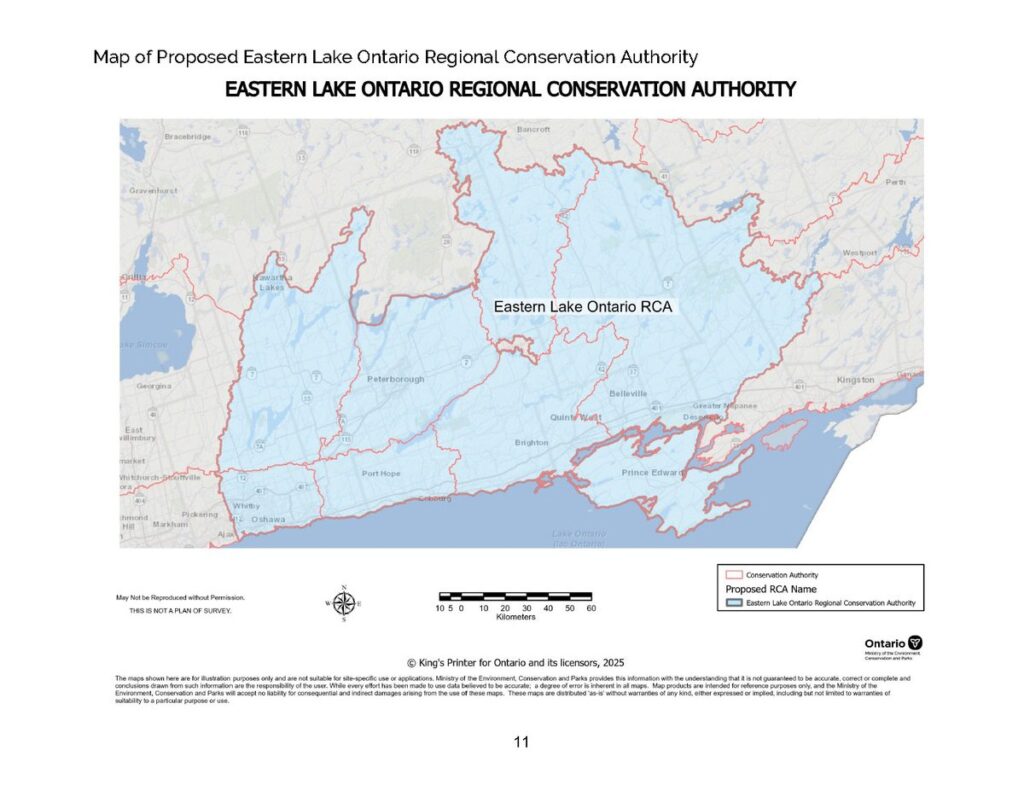Province Proposes Regional Consolidation Affecting Lower Trent Conservation

The Ontario Ministry of the Environment, Conservation and Parks (MECP) has proposed significant structural changes to Conservation Authorities under Bill 68. Under the proposed legislation, Ontario’s 36 Conservation Authorities would be merged into 7 Regional Authorities, reshaping how watershed management is delivered across the province. Under this proposal, Lower Trent Conservation (LTC) would be merged alongside 6 other conservation authorities. Once consolidated the new Eastern Lake Ontario Regional Conservation Authority will be 16,000 km², with 47 municipalities, to oversee programs and services.
Another significant change is the proposal of a new Ontario Provincial Conservation Agency, a centralized Crown agency that would provide provincial coordination, strategic direction and oversight of the seven new regional Conservation Authorities. This represents a significant shift from locally based watershed governance.
LTC is governed by a Board of Directors representing seven municipalities across the current watershed boundary. The proposed regional authority would span a large area across eastern and central Ontario, raising important questions about how local municipalities will be represented. It is unclear how local watershed needs, long-standing local partnerships and watershed expertise will be incorporated into the new structure.
Currently, local municipalities provide just over 58% of LTC’s operating funding, with provincial contributions making up only 2.3 % in flood forecasting and warning program funding and 12.5% for the local and regional Drinking Water Source Protection program, a small share of the annual budget.
For decades, local municipalities, stakeholders, partners, and community organizations have collectively invested millions of dollars into vital watershed services—including floodplain mapping and flood warning systems, long-term environmental and watershed monitoring, conservation areas, restoration projects, support for stewardship enhancements on private properties, environmental education, and community outreach. These programs were built to address the unique needs, risks, and conditions of the Lower Trent watershed, guided by local knowledge and local priorities. Under a large regional model, local municipalities and watershed residents risk losing their voice in decisions that directly affect their communities and local natural resources. This shift could significantly alter how these essential services are delivered, funded, and prioritized, placing at risk the locally driven programs and services that have supported the health and safety of our communities for more than 50 years.
MECP has stated that the proposed restructuring of Conservation Authorities is intended to reduce duplication, increase efficiency, standardize permitting across Ontario, and ensure more consistent alignment with provincial priorities.
- Since 2019, LTC has implemented every legislative and regulatory change introduced by the Province, including updates to programs, policies, governance, and reporting requirements. LTC is operating efficiently and effectively and meeting or exceeding provincial expectations.
- LTC has worked collaboratively with agencies to advance floodplain mapping updates and implement modernized technical standards and involve the public through consultation.
- LTC proactively conducted an internal organizational review to identify and address inefficiencies, reduce duplication, and ensure continuous improvement—demonstrating our commitment to fiscal responsibility and high-quality service delivery.
Centralizing these responsibilities into a large regional authority threatens to erode the local expertise, responsiveness, and decision-making that our municipalities and residents rely on within their communities.
Maps of the proposed regional boundaries and governance changes are now available on the Environmental Registry of Ontario (https://ero.ontario.ca/notice/025-1257). Residents, municipalities, and community partners can review the materials and submit their feedback to the province until December 22.
For more information about Lower Trent Conservation’s programs and services, visit www.ltc.on.ca or contact [email protected].

